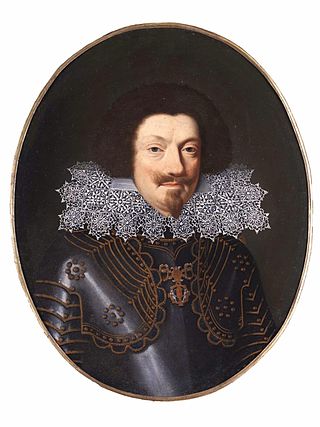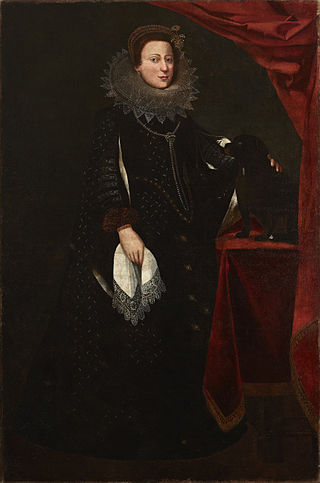
The House of Gonzaga is an Italian princely family that ruled Mantua in Lombardy, northern Italy from 1328 to 1708. They also ruled Monferrato in Piedmont and Nevers in France, as well as many other lesser fiefs throughout Europe. The family includes a saint, twelve cardinals and fourteen bishops. Two Gonzaga descendants became empresses of the Holy Roman Empire, and one became queen of Poland.

Montferrat is a historical region of Piedmont, in northern Italy. It comprises roughly the modern provinces of Alessandria and Asti. Montferrat is one of the most important wine districts of Italy. It also has a strong literary tradition, including the 18th century Asti-born poet and dramatist Vittorio Alfieri and the Alessandrian Umberto Eco.

The Duchy of Mantua was a duchy in Lombardy, northern Italy. Its first duke was Federico II Gonzaga, member of the House of Gonzaga that ruled Mantua since 1328. The following year, the Duchy also acquired the March of Montferrat, thanks to the marriage between Gonzaga and Margaret Paleologa, Marchioness of Montferrat.

Vincenzo Ι Gonzaga was the ruler of the Duchy of Mantua and the Duchy of Montferrat from 1587 to 1612.

Casale Monferrato is a town in the Piedmont region of northwestern Italy, in the province of Alessandria. It is situated about 60 km (37 mi) east of Turin on the right bank of the Po, where the river runs at the foot of the Montferrat hills. Beyond the river lies the vast plain of the Po valley.

The War of the Mantuan Succession (1628–1631) was a conflict related to the Thirty Years' War and was caused by the death in December 1627 of Vincenzo II, the last male heir in the direct line of the House of Gonzaga and the ruler of the duchies of Mantua and Montferrat. Those territories were key to control of the Spanish Road, an overland route that allowed Habsburg Spain to move recruits and supplies from Italy to their army in Flanders. The result was a proxy war between France, which supported the French-born Duke of Nevers, and Spain, which backed a distant cousin, the Duke of Guastalla.

The Commune of Conzano is a municipality located in the south of Casale Monferrato, in the north-west of the italian province of Alessandria.
The town became famous for having been declared, in 1992, as the symbol of the massive emigration of the people to the northern Queensland, Australia, about 1890-1935 period: the ancient town square, named Piazza d'Armi, was renamed in Piazza Australia and Conzano has been twinned with Ingham, Queensland.

The Marchof Montferrat was a frontier march of the Kingdom of Italy during the Middle Ages and a state of the Holy Roman Empire. The margraviate was raised to become the Duchy of Montferrat in 1574.

Anne d'Alençon, Lady of La Guerche, was a French noblewoman and a Marquise of Montferrat as the wife of William IX, Marquis of Montferrat. She acted as Regent of the Marquisate of Montferrat for her son, Boniface from 1518 to his death in 1530.

Ferdinando Carlo Gonzaga was the only child of Duke Charles II of Mantua and Montferrat, and the last ruler of the Duchy of Mantua of the House of Gonzaga.
Giacomo Zanetti (c.1696–1735), born probably in Lugano, was an Italian master builder and architect active in Casale Monferrato.

Camilla Faà di Bruno, also da Casale, also Camilla Faà Gonzaga was an Italian noble who was married secretly, briefly and morganatically to Ferdinando the Gonzaga Duke of Mantua and Duke of Montferrat. Repudiated by her husband she became a nun and the sixteen page memoir which she wrote in 1622 at the behest of her Mother Superior has been described as the first prose autobiography written by an Italian woman. Her story was the subject of Paolo Giacometti’s historical drama Camilla Faa da Casale, first performed at the Teatro Nuovo, Florence on 29 October 1846.

The Diocese of Casale Monferrato is a Latin diocese of the Catholic Church in northwest Italy, a suffragan of the Archdiocese of Vercelli which forms part of the ecclesiastical region of Piedmont. The diocese, which adheres to the Roman Rite, was established on 18 April 1474 for political reasons, to transform the Marquisate of Montferrat into an ecclesiastic territory.
John Jacob Palaeologus was the Margrave of Montferrat from 1418 to 1445.

Isabella Clara of Austria was a Duchess consort of Mantua, Montferrat, Nevers, Mayenne and Rethel by marriage to Charles II, Duke of Mantua and Montferrat.

Margaret Palaeologa, was the ruling Marquise regnant of Montferrat in her own right between 1533 and 1536. She was also Duchess of Mantua by marriage to Federico II, Duke of Mantua. Margaret acted as the regent of the Duchy of Mantua twice during the minority of her sons: for her elder son Francesco III Gonzaga, Duke of Mantua in 1540-1549, and for her younger son Guglielmo Gonzaga, Duke of Mantua, between 1550 and 1556.

The Marquisate or Margraviate of Mantua was a margraviate located in Lombardy, Northern Italy. Placed under the sovereignty of the House of Gonzaga since its erection in 1433, it was further raised to Duchy in 1530.

The War of the Montferrat Succession was a war of succession from 1613 to 1617 over the Duchy of Montferrat in northwestern Italy.

The Paleologo-Oriundi are an Italian family which dubiously claims descent from Flaminio Paleologo, an illegitimate son of John George Palaeologus, Marquis of Montferrat 1530–1533. John George's family, the Palaeologus-Montferrat family descended from Theodore Palaiologos, a son of Byzantine Emperor Andronikos II Palaiologos. Though portions of their recent claimed ancestry are documented, contradictions in their genealogy exist and their descent remains incompletely verified and disputed, with some genealogists wholly dismissing their claims. If they were to be genuine, the Paleologo-Oriundi would be male-line descendants of the last dynasty of Byzantine emperors, though they would not be considered part of that dynasty proper on account of their descent through an illegitimate son.

















